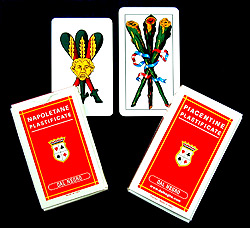Scopa Rules! Briscola Rules!
 I can still remember exactly where I was when I saw Italian cards for the first time. We were taking a break from Italian studies at the Universita’ per Stranieri in Perugia to take in a STING concert during Umbria Jazz. We were holding down our piece of the lawn in a soccer stadium under a sunny summer sky and my new friend Egidio on the neighboring picnic blanket leaned over and said “gioca scopa?” Well, I had never seen cards like the ones in his hand outside Tarot cards and I couldn’t get in the game at all. I vowed that would be the last time that happened to me – ever. At the very next possible moment I got our friend Pepe from Soverato (in Calabria) to show me all the cards and all the games he knew. All our kids have been taught to play Italian cards as soon as they can talk and it has made for many happy hours. In the process, we made sure they knew all their number and suetes in Italian. And it paid off!
I can still remember exactly where I was when I saw Italian cards for the first time. We were taking a break from Italian studies at the Universita’ per Stranieri in Perugia to take in a STING concert during Umbria Jazz. We were holding down our piece of the lawn in a soccer stadium under a sunny summer sky and my new friend Egidio on the neighboring picnic blanket leaned over and said “gioca scopa?” Well, I had never seen cards like the ones in his hand outside Tarot cards and I couldn’t get in the game at all. I vowed that would be the last time that happened to me – ever. At the very next possible moment I got our friend Pepe from Soverato (in Calabria) to show me all the cards and all the games he knew. All our kids have been taught to play Italian cards as soon as they can talk and it has made for many happy hours. In the process, we made sure they knew all their number and suetes in Italian. And it paid off!
Our son, for example, spent one whole summer in Pescara, not speaking Italian but playing cards at the beach all day, every day with a huge posse of neighborhood kids. They all had dog eared decks of cards in thier pockets at all times, as did Zak, and he fit right in. Made his summer.
I like the cards just for the strange and “foreign” look of them. Fair warning not all Dal Negro cards are created equal. Many do not look near foreign enough for me. In fact they look strangely like our regular playing cards but with only 40 cards vs 52. Can’t just walk into a store (any Sale e Tabacchi in Italy has cards if they are worth their salt at all) and ask and say “gimme a pack of cards” and expect to find true graphic happiness. Napoletane cards are always correct. As you can tell from some of the pictures they are the smallest, most portable size. I like them and their graphics but they are just not quite as easy to handle. Personal taste. My most excellent favorite is the Piacentine set. Great spooky medievel graphics, perfect size, they work for me. Notice: read the type on the cover of the box. All boxes are usually red and white and the city name where the cards are considered “from” is just the first line. They all look alike on the outside.
I think it is grand that in this age of CDs, TVs, video games, emails and IM that almost every Italian, of every age, knows full well how to play all the classic games and that most bars and cafes come equipped with both cards and someone willing to play.
All about the cards
Unlike our decks of cards (which Italians call “french cards”) in an Italian deck there are only 40 cards. 4 suits of 10. They are as follows:
- Denavi (day navi) round gold pieces, money-like, which I think are like our Diamonds.
- Coppe (co-pay) drinking cups which as containers, if you stretch the point could be seen as somewhat cup like.
- Spade (spa day) the Italian word for sword is spade. A coincidence? I think not.
- Bastoni (baas tony) now we’re getting somewhere. Clubs! Get it? Much more club-like than our shamrock-like symbols. How did that ever evolve I wonder? Viewr Fabio writes taht this is the more popular use, but classically this ssuite is sometimes referred to as Mnzze.
In any suit there are 10 cards, 7 numbered and the three face cards. Instead of saying face cards, Italians say “dressed” cards – “veste” meaning cards with people on them.
More specific details and rules about these fun Italian cards under Scopa Rules and Briscola Rules. So, pick a game, any game, and getting playing like a real Italian! Ifyou read Italian and want to get the true long version of hte rules go to Fabio’s Giocolab (Game Lab) Site. Also, look under the catigory "Carte". This is a huge site with every kind of game/rules carefully spelled out. Thank you Fabio for checking out our site and setting us straight as some good details! Much Appreciated!